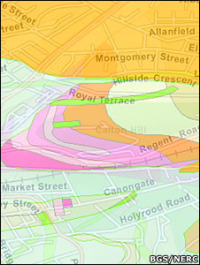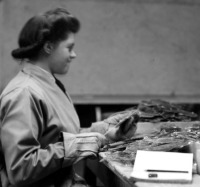The map that changed the world goes digital
/ Ancient volcanic rock under EdinburghFor those of you who devoured Simon Winchester's "The Map that Changed the World" about geologist William Smith's journey to create the first geologic map of England and Wales, the first geologic map in the world, this news will please you. (Smith published the 10' x 16' map in 1815. His pivotal insights were that each local outcrop of rock strata was a portion of a single universal sequence of strata and that these rock strata could be distinguished, followed for great distances, and their relative date ascertained by means of imbedded fossilized organisms. His work kick-started the science of geology, and contributed to the theory of evolution. Modified from Wikipedia.)
Ancient volcanic rock under EdinburghFor those of you who devoured Simon Winchester's "The Map that Changed the World" about geologist William Smith's journey to create the first geologic map of England and Wales, the first geologic map in the world, this news will please you. (Smith published the 10' x 16' map in 1815. His pivotal insights were that each local outcrop of rock strata was a portion of a single universal sequence of strata and that these rock strata could be distinguished, followed for great distances, and their relative date ascertained by means of imbedded fossilized organisms. His work kick-started the science of geology, and contributed to the theory of evolution. Modified from Wikipedia.)
Now, as the BBC reports, the British Geological Survey's (BGS) has released their new OpenGeoscience portal, which allows the public to study all the UK's geology via a variety of webGIS formats (e.g. Google, and ArcServer). There is a viewer for bedrock geology and the overlying superficial deposits, and another for more geological layers — artificial ground, faults, mass movements, etc.
 Worker at Pitlochry depot, Perthshire, processing Scottish mica.In a companion effort, the BGS is also releasing images from their historic image archive: 50,000 images are searchable and usable for non-commercial purposes. These images include lovely photography of some of Britain's icons of geology, but also includes image from 100 years ago of miners, explorers, and early 20th century industry.
Worker at Pitlochry depot, Perthshire, processing Scottish mica.In a companion effort, the BGS is also releasing images from their historic image archive: 50,000 images are searchable and usable for non-commercial purposes. These images include lovely photography of some of Britain's icons of geology, but also includes image from 100 years ago of miners, explorers, and early 20th century industry.
Reproduced with the permission of the British Geological Survey ©NERC. All rights Reserved